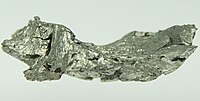
Photo from wikipedia
We report the growth, structural, and electrical characterization of epitaxial, strained SixGe1−x-Ge-Si core-double-shell nanowire heterostructures designed to provide quantum confinement of holes and electrons in the compressively strained Ge and… Click to show full abstract
We report the growth, structural, and electrical characterization of epitaxial, strained SixGe1−x-Ge-Si core-double-shell nanowire heterostructures designed to provide quantum confinement of holes and electrons in the compressively strained Ge and tensile-strained Si shells, respectively. The growth utilizes the vapor-liquid-solid growth mechanism for the SixGe1−x core, followed by a sequence of in-situ ultra-high-vacuum chemical vapor deposition for the epitaxial Ge and Si shell growth. Using a combination of micro-Raman spectroscopy on individual nanowires and lattice dynamic theory, we determine a large compressive (tensile) hydrostatic strain of up to −0.9% (0.67%) in the Ge (Si) shell. We demonstrate p- and n-type metal-oxide-semiconductor field-effect transistors using SixGe1−x-Ge-Si core-double-shell nanowires as channel and observe a 500% (20%) enhancement of the average hole (electron) mobility compared to control devices using Si nanowires, due to an increased hole (electron) mobility in the compressively strained Ge (tensile strained Si) shell. An analysis of the hole transport provides the valence band offset in the core-double-shell nanowire heterostructures.We report the growth, structural, and electrical characterization of epitaxial, strained SixGe1−x-Ge-Si core-double-shell nanowire heterostructures designed to provide quantum confinement of holes and electrons in the compressively strained Ge and tensile-strained Si shells, respectively. The growth utilizes the vapor-liquid-solid growth mechanism for the SixGe1−x core, followed by a sequence of in-situ ultra-high-vacuum chemical vapor deposition for the epitaxial Ge and Si shell growth. Using a combination of micro-Raman spectroscopy on individual nanowires and lattice dynamic theory, we determine a large compressive (tensile) hydrostatic strain of up to −0.9% (0.67%) in the Ge (Si) shell. We demonstrate p- and n-type metal-oxide-semiconductor field-effect transistors using SixGe1−x-Ge-Si core-double-shell nanowires as channel and observe a 500% (20%) enhancement of the average hole (electron) mobility compared to control devices using Si nanowires, due to an increased hole (electron) mobility in the com...
Journal Title: Applied Physics Letters
Year Published: 2018
Link to full text (if available)
Share on Social Media: Sign Up to like & get
recommendations!